Best temperature and relative humidity for growing cannabis
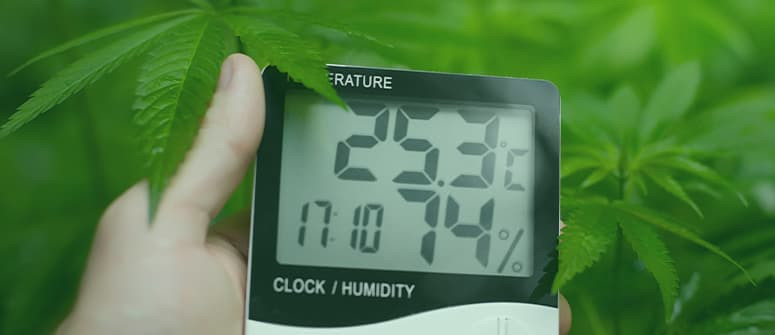
From germinating your seeds right on through to curing, temperature and humidity have a huge impact on the cannabis plant, and properly managing these conditions can make or break a harvest. Find out what you need to do to keep these conditions optimal during each stage of a cannabis grow, so you can secure a huge bounty of pristine buds.
Contents:
Temperature and relative humidity are crucial measures when growing weed. And while cannabis is renowned for being a hardy plant, prolonged exposure to subpar temperature and humidity levels can cause stress, attract pests and pathogens, and even kill plants altogether. In this article, we'll teach you all there is to know about the optimal temperature and humidity conditions for cannabis at all stages of your grow, from seedling through to harvest—and beyond!
UNDERSTANDING RELATIVE HUMIDITY AND TEMPERATURE
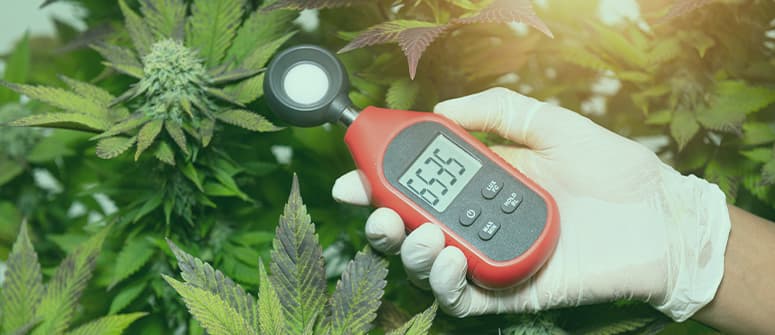
Whenever we talk about humidity in relation to cannabis cultivation, we're referring to "relative humidity". Relative humidity is a measure of how much water vapor is present in the environment relevant to the temperature. This might seem trivial, but it's actually very important; since warm air can naturally hold more vapor than cold air, a humidity reading of 60% at 20°C isn't the same as 60% humidity at 30°C, for example.
As an indoor cannabis grower, you need to be armed with both a thermometer and hygrometer, or an all-in-one thermo-hygrometer, to accurately measure temperature and humidity levels. You'll find a wide variety of digital and analogue devices online or at your local nursery or grow store.
Measuring relative humidity and temperature is crucial for growing happy, healthy cannabis plants, as constant exposure to extreme temperatures and humidity stresses even the toughest weed strains. And excess stress can lead to stunted growth, reduced yields, hermaphroditism, or death of a crop—so it pays to be mindful.
THE PROBLEM WITH EXTREME TEMPERATURE OR HUMIDITY
Extremely hot or cold temperatures can affect many biological processes within plants. At temperatures above 30°C, many of the enzymes involved in photosynthesis start to work less efficiently. This leads to stunted growth, which you'll either have to compensate for with a longer veg time, or, in the case of autoflowers, settle for smaller plants with reduced yield potential.
Another major concern with high temperatures is pests. Many common cannabis pests (such as spider mites, thrips, whiteflies, and white powdery mildew) love hot temperatures. Warm soil temperatures also affect cannabis' ability to uptake nutrients, which can lead to nutrient deficiencies or nutrient lockout.
Cold temperatures also affect the enzymes responsible for photosynthesis, and thereby cause stunted growth, and can also create an ideal environment for the growth of certain forms of mould. Botrytis, for example (the fungi that causes bud rot), thrives in cold temperatures.
Just like subpar temperatures can have detrimental effects on cannabis, so can subpar humidity levels. The main concern with high humidity is mould (some moulds thrive in warm, humid climates, while others prefer cold and damp conditions). Both super-humid and super-dry conditions can also attract pests; for example, fungus gnats and spider mites like humid and dry conditions, respectively.
HOW TO MEASURE RH AND TEMPERATURE WHEN GROWING CANNABIS
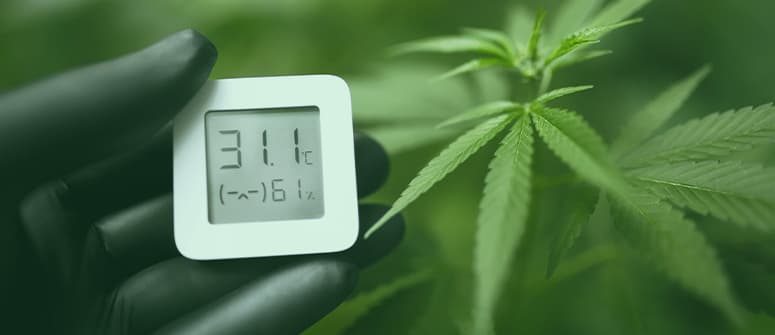
The simplest, most accurate, and most reliable way to measure the temperature and humidity in your grow room or tent is with the aforementioned thermo-hygrometer. There are many different makes and models on the market, but we recommend the digital models for their ease of use and cheap prices.
Make sure to keep your device out of direct light while in use. Also, temperature and humidity levels can vary greatly above and below the canopy, especially if you're growing dense indica strains that are particularly effective at trapping warm air and water vapor. Using multiple thermo-hygrometers will help ensure balanced temperature and humidity throughout a large room or tent.
OPTIMAL HUMIDITY AND TEMPERATURE FOR GROWING CANNABIS
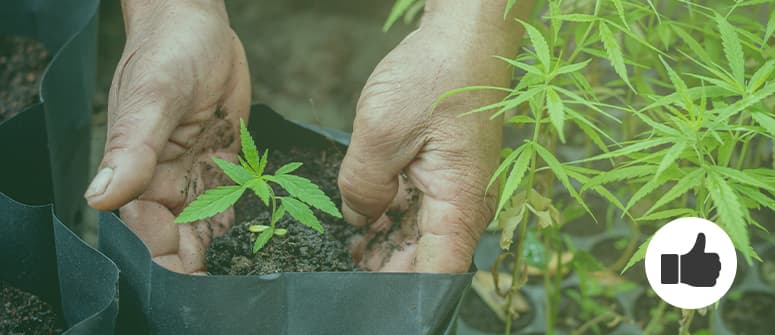
The optimal temperature and relative humidity conditions for a cannabis plant depend primarily on the stage of development. Seedlings, for example, like warm, humid conditions, while flowering plants usually prefer cooler nighttime conditions and less humidity. Below, we'll highlight the optimal temperature and humidity levels for cannabis in the seedling, vegetative, and flowering phases.
SEEDLINGS / CLONES
- Seedlings and clones like temperatures of 20–25°C and RH of 65–70%.
- These warm, humid conditions promote rooting and allow seedlings/clones to uptake water via the leaves until they develop roots.
Cannabis seedlings and clones are very fragile, and stark changes in their growing conditions can quickly lead to stunted growth or even death. As they develop roots, seedlings typically like warm and humid conditions. Most growers keep their seedlings/clones in a dome or seed germinator under cool lights, and maintain high humidity by regularly misting the specimens with a spray bottle.
VEGETATIVE PLANTS
- Vegetative plants like warmer, less humid conditions.
- We recommend raising the temps in your grow room/tent to 22–28°C and reducing humidity levels gradually until you reach a sweet spot of roughly 60% RH.
Cannabis' hardy nature shines through best during its vegetative growth phase. While the seedling phase tends to be a bit touch-and-go for most beginner growers, the vegetative phase tends to be a lot easier to manage. Once your plants have established roots and developed a few nodes and true leaves, you should see them shoot up in height, producing plenty of healthy, lush foliage.
FLOWERING PLANTS
- Flowering cannabis plants like cooler temperatures and low humidity.
- Keep temperatures between 20–26°C and RH at 50% during the lights-on period. If possible, drop temperatures by roughly 5–8°C during lights off.
The flowering stage is super exciting, but can prove challenging for inexperienced growers. Some strains can stretch considerably as they prepare to bloom, and changes in nutrients, lighting, temperature, and humidity conditions should be implemented gradually to avoid shocking plants.
LATE-FLOWERING PLANTS
- During the final 2 weeks of flowering, we recommend dropping the temperature to 20–23°C during lights on and 18–20°C during lights off, and reducing RH to 30%.
If you got excited when you first saw your ladies start developing flowers, wait until you see them as they approach harvest. Modern cannabis strains have been specially bred to produce big, dense, and super resinous buds. To accommodate the dense structure of these flowers, it's important to keep humidity levels in your room/tent as low as possible. Colder temperatures, especially during lights off, can promote more resin production and also bring out vibrant colours in some strains.
HOW TO ADJUST HUMIDITY LEVEL AND TEMPERATURE
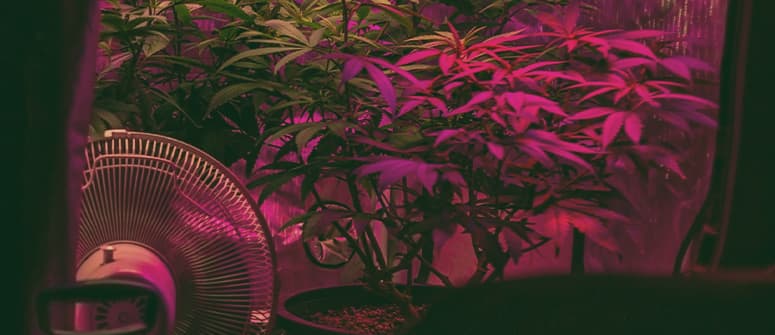
You now know what temperature and humidity levels are best for cannabis during the different stages of its life cycle. But what are the best and most efficient ways to adjust these metrics and create the ideal environment for your plants?
In what follows, we outline some of the best ways to raise and lower the temperature and RH in your tent or grow room.
HOW TO INCREASE HUMIDITY LEVELS FOR CANNABIS
- Invest in a humidifier.
- Keep open containers of water placed around the grow room.
- Regularly mist the air in your grow room with a spray bottle.
HOW TO INCREASE TEMPERATURES FOR CANNABIS
- Use a high-watt HPS grow light (the more watts, the more heat it will produce).
- Place a heat mat on the floor of your grow room/tent.
- Invest in a small space heater with a thermostat that will automatically turn off once the ideal temperature in the room is reached.
HOW TO LOWER HUMIDITY LEVELS FOR CANNABIS
- Invest in a dehumidifier.
- Increase airflow around the room using oscillating fans.
- Invest in more efficient intake fans to increase the amount of fresh air drawn into the room/tent.
- Water your plants before lights on so the soil dries out faster under the head of the lights.
HOW TO LOWER TEMPERATURES FOR CANNABIS
- Increase airflow into and around the room/tent using oscillating fans.
- Run your lights during the night and keep them off during the day.
- Use a cool tube when growing under HPS lights, or switch to LEDs if possible.
- Invest in an air conditioner (which will also reduce the RH in your room).
BEST HUMIDITY LEVELS AND TEMPERATURES FOR DRYING AND CURING
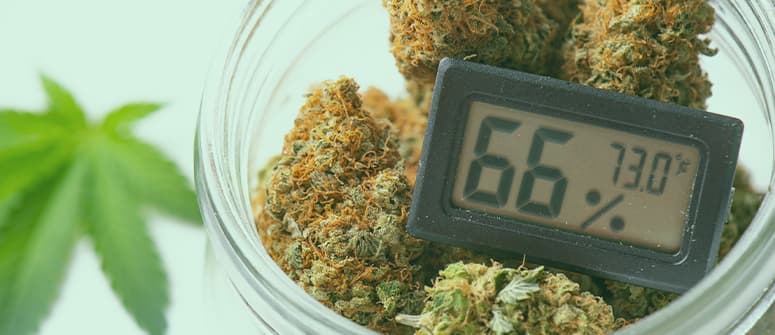
Monitoring humidity and temperature is just as important during drying and curing as it is when growing cannabis. While every grower has their own approach to drying and curing, below are the standard temperature/RH levels used during these steps.
DRYING
- First 3 days: 20°C and 50% RH.
- From day 3 onward: 17–18°C and 60% RH.
- Keep a fan on somewhere in your drying room to keep air circulating.
CURING
- Keep temperatures at roughly 20°C.
- The ideal RH for curing cannabis is 59–63%. Remember to "burp" your jars regularly (3–5 times a week) during the first weeks of curing to keep humidity levels optimal.
- Invest in humidity packs for your curing jars to maintain optimal levels in the long term.
From the time you germinate your seeds to the day you harvest, trim, and dry your buds, temperature and humidity have a direct impact on the health of your plants and the quality of your harvest. In this article, we've done our best to summarise optimal temperature and humidity levels for cannabis at all stages of the plant's life, so make sure to keep it handy as you hone your skills in the grow room.




